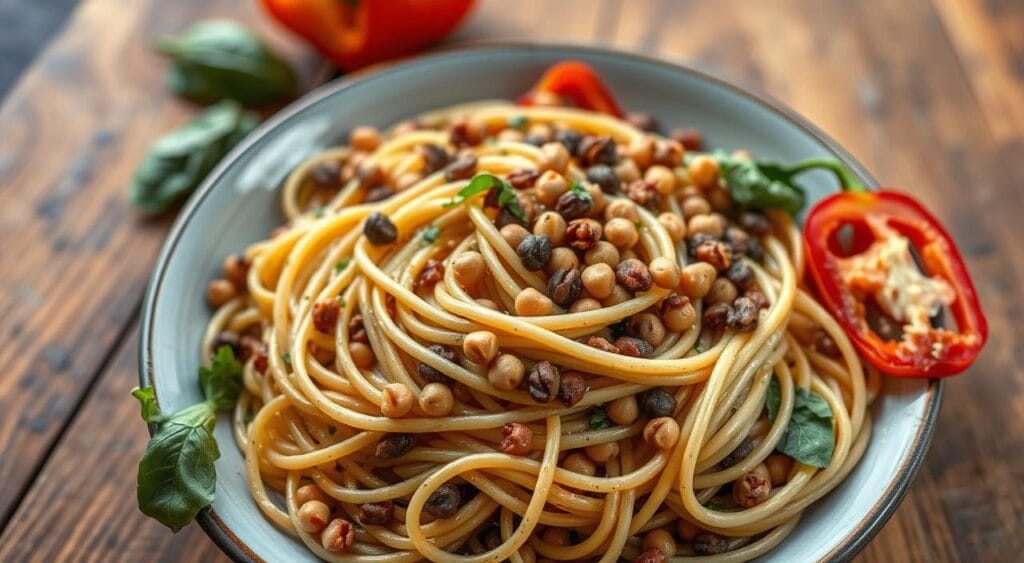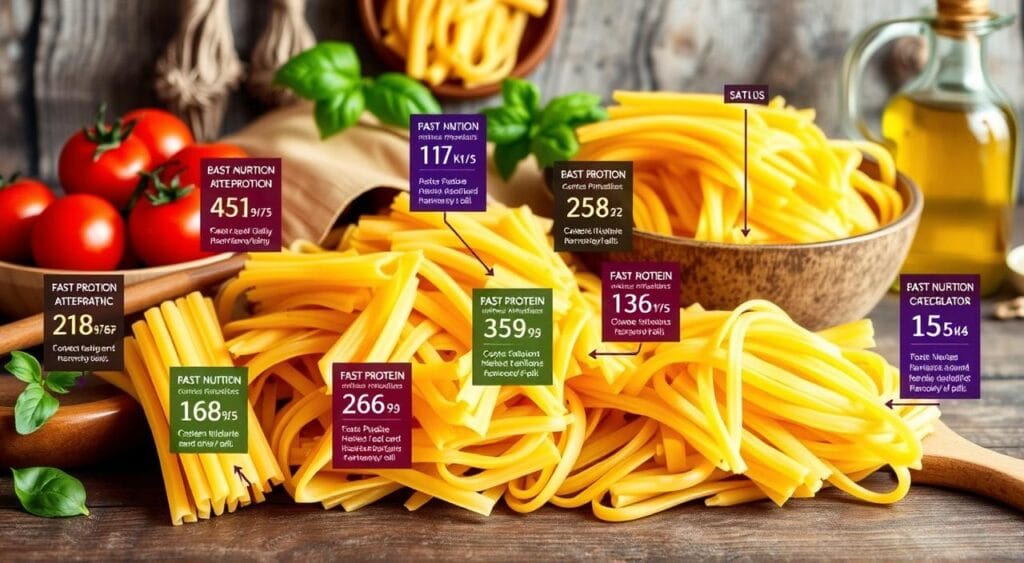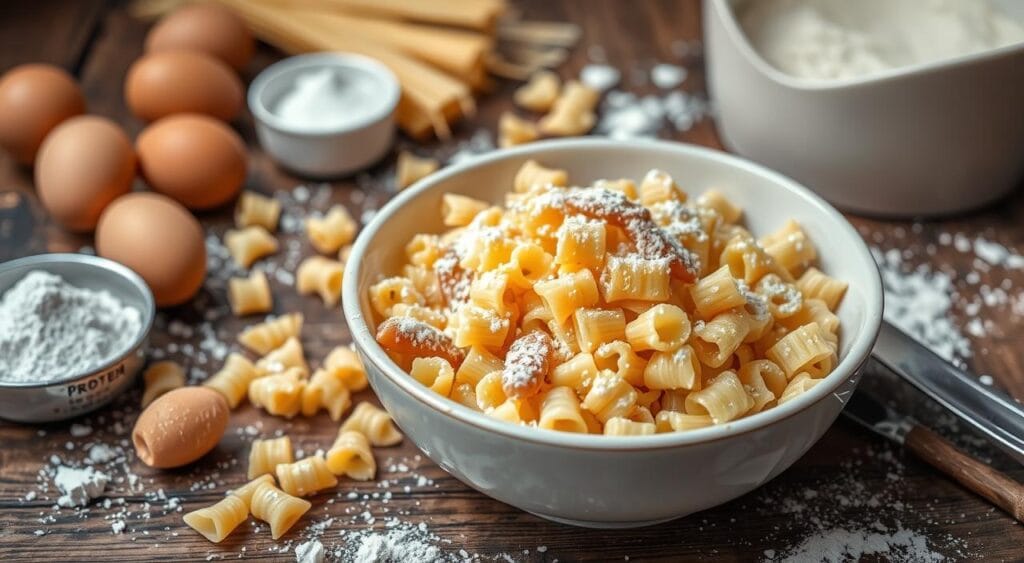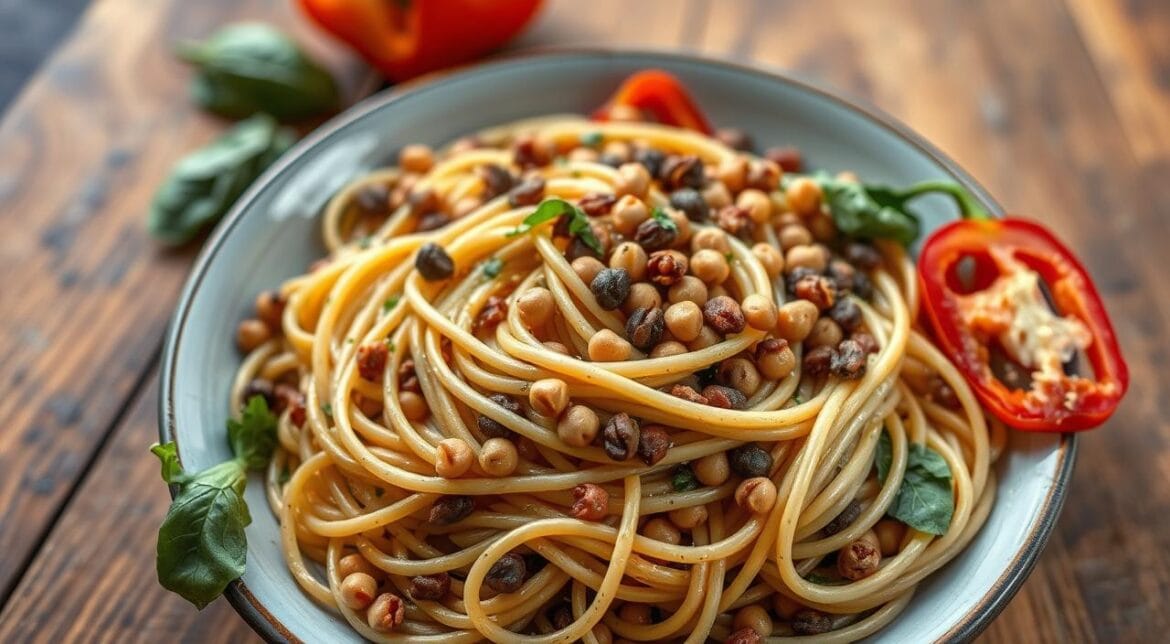Table of Contents
Pasta is a favorite food for many, enjoyed everywhere for its taste and comfort. But, there’s confusion about its protein content. In this guide, we’ll look at the protein in different pasta types. We’ll answer common questions and give tips for adding pasta to your diet.

Key Takeaways
- Pasta is mostly carbs, but it has some protein. The amount changes with the pasta type.
- Regular wheat pasta has about 7-8 grams of protein per cup when cooked.
- Whole grain and other grain pasta, like quinoa or chickpea, have more protein.
- There’s also protein-rich pasta for those wanting more protein in their diet.
- Adding protein-rich foods to your pasta dishes can increase the meal’s protein.
Understanding Pasta’s Nutritional Profile
Pasta is a favorite in many homes for its taste, texture, and versatility. But, it’s also packed with nutrients that help keep your diet balanced. Let’s look at what pasta offers in terms of macronutrients and essential nutrients.
Basic Macronutrients in Pasta
Pasta is mostly carbohydrates, which give us energy. It also has some protein and very little fat.
Types of Nutrients Found in Regular Pasta
Pasta is not just carbs; it’s also rich in vitamins and minerals. Here are some key ones:
- B Vitamins: Pasta has B vitamins like thiamin, niacin, and folate. They help with energy and nerve health.
- Iron: Pasta has iron, which is vital for carrying oxygen in our blood.
- Selenium: This mineral boosts our immune system and fights off free radicals.
Carbohydrate to Protein Ratio
The carbohydrate to protein ratio in pasta is mostly carbs. But, some types like whole-grain or protein-enriched pasta have more protein.
Knowing pasta’s nutritional makeup helps you use it wisely in your diet. It’s a great way to add variety and nutrients to your meals.

Does Pasta Contain Protein? Breaking Down the Facts
Many people wonder if pasta has protein. The truth is, yes, pasta does have protein. But, the amount can change based on the pasta type.
Regular wheat pasta usually has about 7-8 grams of protein in a 2-ounce serving. This protein mainly comes from the wheat flour. Compared to foods like meat, eggs, or legumes, pasta’s protein is considered moderate.
| Food Item | Protein Content (per 2-ounce serving) |
|---|---|
| Regular Wheat Pasta | 7-8 grams |
| Chicken Breast | 26 grams |
| Eggs (2 large) | 12 grams |
| Lentils | 9 grams |
Pasta may not be the top protein source, but it’s still important in a balanced diet. Pairing pasta with protein-rich foods like chicken, beans, or cheese makes for a nutritious meal.

“Pasta can be a great source of complex carbohydrates and a moderate amount of protein, making it a versatile and nutritious part of an overall healthy diet.”
Different Types of Pasta and Their Protein Content
The type of pasta you pick can really affect how much protein you get. Traditional wheat pasta is common, but there are other kinds that have more protein. These include whole grain and alternative grain pasta.
Traditional Wheat Pasta Protein Levels
Many people love traditional wheat pasta, but it’s good to know about its protein. A serving of cooked wheat pasta usually has 7-8 grams of protein. The exact amount can vary based on the brand and recipe.
Whole Grain Pasta Protein Content
Whole grain pasta is a great choice if you want more protein. These pastas, made from whole wheat or other whole grains, have 8-10 grams of protein per serving. This is because they include the germ and bran, which are packed with nutrients.
Alternative Grain Pasta Options
- Quinoa Pasta: Quinoa pasta is made from quinoa, a superfood. It has about 10-12 grams of protein per serving.
- Chickpea Pasta: Chickpea pasta is made from chickpea flour. It has 14-20 grams of protein per serving, making it a top choice for protein.
- Lentil Pasta: Lentil pasta is made from lentils. It has 13-15 grams of protein per serving, along with other nutrients.
When picking pasta, think about your protein needs and what you like to eat. Whole grain and alternative grain pasta can help you get more protein while enjoying your favorite pasta dishes.
High-Protein Pasta Alternatives in the Market
More people are looking for healthy food options, including high-protein pasta. The market now has many protein-rich pasta choices. These include chickpea noodles and lentil pasta, offering a nutritious twist on pasta.
Banza is a well-known brand with chickpea noodles. These noodles have 25 grams of protein per serving. Barilla’s Protein+ pasta also has a lot of protein, with up to 17 grams per serving.
Explore Cuisine offers pasta made from mung bean, edamame, and black bean. These pastas are not only nutritious but also have unique flavors and textures. They are great for those who want to try new things in the kitchen.
| Brand | Protein Noodles/Pasta | Protein Content (per serving) |
|---|---|---|
| Banza | Chickpea-based Protein Noodles | 25 grams |
| Barilla Protein+ | Wheat and Legume Flour Pasta | 17 grams |
| Explore Cuisine | Mung Bean, Edamame, and Black Bean Pasta | Varies, up to 25 grams |
These protein-rich pasta options are not only healthier but also meet different dietary needs. As more people look for protein in their pasta, the market will keep growing. This means more choices for everyone to make better pasta meals.
Benefits of Protein-Enriched Pasta for Your Diet
Adding protein-enriched pasta to your meals can bring many benefits. It helps with weight control, boosts athletic performance, and aids in muscle recovery and growth. Let’s see how these protein-rich pasta options can improve your health and wellness.
Weight Management Advantages
Protein-enriched pasta is great for managing your weight. It has more protein, which makes you feel full and satisfied. This can stop you from eating too much and help you avoid gaining weight.
Research shows that eating more protein can help burn fat and keep your muscles strong while losing weight. This makes it a good choice for keeping a healthy weight.
Athletic Performance Benefits
For athletes and those who are active, protein-enriched pasta is a big plus. It has more protein, which helps build and repair muscles. This enables you to train harder and recover more quickly.
Eating protein-rich pasta can fuel your workouts. It helps you train harder and reach your fitness goals.
Muscle Recovery and Growth
Protein is key for muscle recovery and growth. Protein-enriched pasta is a tasty and easy way to get this important nutrient. The amino acids in protein help fix and grow muscle tissue.
This speeds up your body’s recovery and helps build muscle over time. So, protein-enriched pasta is great for athletes, bodybuilders, and anyone wanting to get stronger and more fit.
“Incorporating protein-enriched pasta into your diet can be a game-changer for your health and fitness goals.”
How to Add More Protein to Your Pasta Dishes
Pasta is a favorite in many homes, but it often lacks protein. To make your pasta meals more nutritious, there are easy ways to add protein. You can use protein-rich toppings or flavorful sauces to make your pasta dishes more satisfying and protein-packed.
Protein-Rich Pasta Toppers
- Grilled or sautéed chicken, shrimp, or lean ground turkey
- Crumbled feta, parmesan, or ricotta cheese
- Toasted nuts, such as almonds or walnuts
- Cooked beans or lentils
- Hard-boiled eggs, sliced or chopped
Protein-Enhanced Pasta Sauces
You can also add protein to your pasta sauces. Here are some ideas:
- Creamy cashew or almond-based sauce
- Ground turkey or lean beef in a marinara or bolognese sauce
- Pesto made with pine nuts, walnuts, or almonds
- Protein-packed nut butter, such as peanut or almond butter, in a creamy sauce
Protein-Rich Pasta Accompaniments
Adding protein-rich side dishes can also increase your meal’s protein. Try serving your pasta with:
- Grilled or roasted vegetables, such as broccoli or Brussels sprouts
- A side salad topped with sliced chicken, hard-boiled eggs, or chickpeas
- Garlic-herb roasted chickpeas or edamame
By adding these protein-rich ingredients to your pasta, you can make your meals more nutritious. Enjoy a more satisfying and balanced dining experience.
Comparing Regular Pasta vs. Protein-Enhanced Varieties
Choosing between regular and protein-enriched pasta can affect your diet and cooking. Let’s look at the main differences to help you decide.
Taste and Texture Differences
Regular pasta is made from wheat flour and tastes classic and smooth. Protein-enhanced pasta, with ingredients like chickpea or lentil flour, feels firmer and tastes earthier.
Cost Considerations
Protein-enhanced pasta costs more than regular pasta. This is because it uses special ingredients and making processes. But, the extra protein might be worth the extra cost for some.
Nutritional Value Comparison
Protein-enhanced pasta has more protein than regular pasta. It can have up to 20 grams of protein per serving. This is great for those who want to build muscle, manage weight, or improve overall health.
| Nutritional Comparison | Regular Pasta | Protein-Enhanced Pasta |
|---|---|---|
| Protein (per serving) | 6-8 grams | 15-20 grams |
| Carbohydrates (per serving) | 40-45 grams | 30-35 grams |
| Fiber (per serving) | 2-3 grams | 4-6 grams |
Choosing between regular and protein-enhanced pasta depends on your diet and preferences. Think about your fitness goals, budget, and taste to pick the best option for you.
Best Practices for Cooking Protein-Rich Pasta
Cooking protein-rich pasta needs some extra steps to get the most nutrition. Whether it’s traditional wheat pasta or high-protein options, these tips will help you make a tasty and healthy meal.
Cooking Time and Texture
Protein-enriched pastas might take a bit longer to cook than regular pasta. Always check the package for cooking times and test the pasta often. You want it to be firm but not hard, keeping its shape well.
Seasoning and Sauce Pairings
Protein-rich pasta can handle strong flavors. Try different herbs, spices, and sauces like tomato or cream. But remember, the pasta’s taste might be a bit different because of the protein.
Cooking Techniques
- Cook the pasta in salted, boiling water to help enhance the flavor.
- Toss the cooked pasta with a small amount of olive oil or butter to prevent sticking.
- If the pasta seems dry, reserve a bit of the cooking water to thin out the sauce and keep the dish moist.
By using these cooking protein pasta tips, you’ll make a meal that’s both healthy and tasty. It will meet your dietary needs and satisfy your taste buds.
| Cooking Tip | Benefit |
|---|---|
| Cook pasta in salted water | Enhances flavor |
| Toss with oil or butter | Prevents sticking |
| Reserve cooking water | Keeps pasta moist |
“Cooking protein-rich pasta is all about finding the right balance between texture, flavor, and nutrition.”
Is Protein Pasta Healthy?
Many people wonder if protein pasta is healthy. The answer is not simple. It depends on several factors. Let’s look at the good and bad sides of adding protein pasta to your meals.
The Health Benefits of Protein Pasta
One big plus of protein pasta is it helps with weight control. The extra protein makes you feel full longer. This can stop you from eating too much and helps keep calorie intake in check. It’s also great for muscle recovery and growth, perfect for those who are active or athletes.
- Aids in weight management by encouraging a sense of fullness.
- Aids in muscle recovery and growth, benefiting active individuals
- May assist in regulating blood sugar levels, making it a suitable choice for individuals with diabetes.
Potential Drawbacks of Protein Pasta
Even though protein pasta is a better choice than regular pasta, there are downsides. Some may have extra ingredients or processing that can lower their nutritional value. Also, the extra protein might not be right for everyone, especially those with certain diets or health issues.
- Potential for added ingredients or processing that can affect nutritional value
- Increased protein content may not be suitable for all dietary needs or restrictions
- Cost of protein-enriched pasta may be higher compared to regular pasta
Whether or not to add protein pasta to your diet depends on your health goals and what you like to eat. It’s wise to talk to a doctor or dietitian before making any big changes.
“Protein-enriched pasta can be a valuable addition to a balanced diet, but it’s important to consider individual needs and potential drawbacks.”
Incorporating Protein Pasta into Special Diets
Achieving the right balance of nutrients in specialized diets can be challenging. But, protein pasta for special diets and gluten-free protein pasta offer new options. These can be great for those on vegetarian, vegan, gluten-free, or low-carb diets.
Vegetarian and Vegan Diets
Vegetarians and vegans often miss out on protein from traditional pasta. Luckily, protein pasta for special diets from plants like chickpeas or lentils can help. It adds protein without changing your diet.
Gluten-Free Diets
Gluten-free dieters have found it hard to find good pasta. Now, gluten-free protein pasta made from quinoa or brown rice is available. It offers both taste and nutrition.
Low-Carb Diets
Low-carb dieters can’t have regular pasta because of its carbs. But, protein pasta for special diets from almond flour or shirataki noodles is a better choice. It’s low in carbs but still tasty.
Exploring protein-enriched pasta can change your cooking world. These options let you enjoy pasta while meeting your dietary needs. It’s a win-win for both your taste buds and your health.
Conclusion
Pasta can be a great part of a balanced diet, even though it’s not always high in protein. Now, there are many types of pasta that have more protein. This is good for your fitness and health goals.
Choosing the right pasta is important. You can pick from whole grain, alternative grain, or protein-fortified options. Knowing what you’re eating helps you make better choices. This way, pasta can be a key part of your meals.
In the end, protein in pasta summary shows that pasta can be part of a healthy diet. By looking at the pasta protein intake options, you can enjoy pasta in a nutritious way.
FAQ
Does pasta contain protein?
Yes, pasta has some protein. But, the amount can change based on the pasta type. Wheat-based pasta has less protein. Pasta made from chickpeas or lentils has more.
What types of nutrients are found in regular pasta?
Regular pasta is mostly carbs. It also has a bit of protein and very little fat. It has vitamins like B vitamins, iron, and magnesium, which are good for you.
How does the protein content in pasta compare to other foods?
Pasta has less protein than meat, eggs, or legumes. For example, chicken breast has about 30 grams of protein. Pasta has around 7-8 grams per serving.
What is the protein content in different types of pasta?
Pasta’s protein varies by type. Wheat-based pasta has 7-8 grams per serving. Whole grain pasta has 8-10 grams. Pasta made from chickpeas or lentils can have up to 25 grams.
What are some high-protein pasta alternatives available in the market?
There are many high-protein pasta options. Banza is made from chickpeas. Barilla Protein+ is a blend of wheat and legumes. Explore Cuisine uses various grains and legumes. These have more protein than regular pasta.
What are the benefits of consuming protein-enriched pasta?
Protein-enriched pasta can help with weight management and athletic performance. It aids in muscle recovery and growth. It also keeps you full longer and supports your body’s functions.
How can you add more protein to your pasta dishes?
You can add protein by using lean meats like chicken or shrimp. Try protein-rich sauces or toppings like pesto with nuts. Pair pasta with legumes or a salad with nuts or seeds.
Is protein pasta healthier than regular pasta?
Protein pasta can be healthier than regular pasta. It has more protein, which is good for weight and muscle health. But, look at the whole nutritional profile to judge its healthiness.
How can protein pasta be incorporated into special diets?
Protein pasta fits into many diets, like vegetarian, vegan, gluten-free, and low-carb. Choose the right type, like chickpea or lentil pasta, to meet dietary needs while enjoying a protein-rich dish.

